Archive for the ‘Around the House’ Category
Sacked Out in the Sun

Nala Kitty found a warm spot on the bedroom floor; sun beaming in from a cloudless sky.
Make Your Own Honey Cow
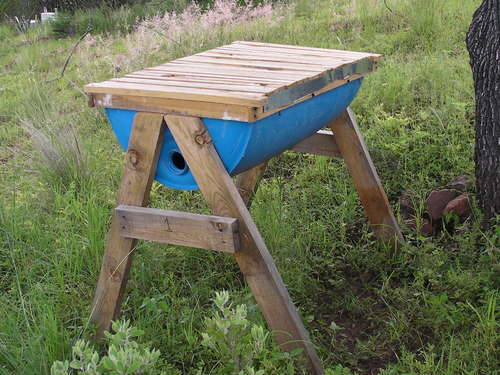
Beekeeping is an art form that dates back thousands of years. It was a DIY project undertaken by both farm families and commercial enterprises. It is said that one hive will produce enough honey to supply a family for one year with enough left over to sell. That’s why small honey production has been a staple on small farms or homesteads for centuries.
Anyone can produce honey at home. Many different kinds of hives can be used. But, for the suburban homesteader city ordinances and zoning codes could be your biggest hurdle so check those out first. If you are lucky enough to be able to house a hive check out this inexpensive and simple design called the Honey Cow by Instructables.com
The Honey Cow is designed to mimic nature as much as possible. Unlike commercial hives that have frames, a foundation or excluders the Honey Cow only has top bars, allowing the bees to do naturally what they would do in a fallen log: build beautiful, natural combs.
It’s easy to make and manage, which makes it perfect for the beginner beekeeper. Plus it’s less intrusive to the bees.
To make your own Honey Cow check out the step-by-step instructions at instructables.com
Start Your Own “Front Porch Farm Stand”
Several years ago I spent part of October in Vermont and up state New York. The trip was everything I had seen in pictures and more. The weather was cool and crisp, the people friendly and warm, the towns historical and picturesque. But, what struck me the most was the wonderful road-side stands with their quaint “honor boxes”, overflowing with homegrown flowers, pumpkins, squash, veggies, even bales of hay and jars of honey. They were artfully arranged on wagons or tables or wooden boxes. It was wonderful to see this kind of business mindedness, even if it was on a small scale.
I was so taken by the stands that the dashboard of my rental car looked somewhat like the LA Produce Market by the time my trip was over; it was brimming with purchases. It got me thinking though; I think that’s what makes travel so wonderful – pulling together ideas from everywhere you go and incorporating them into your own life and situation.
A variation of the Vermont honor stand was born the following growing season as the Front Porch Farm Stand – sort of. I wasn’t totally convinced that my produce would be paid for, considering the area of southern California I live in, so instead of arranging it at the end of my driveway (like I had seen in VT) I made a sign from a piece of charcoal slate and hung it on the bracket of my mailbox. In colored chalk I wrote the “specials of the day” – eggs, peaches, herbs, pumpkins and gourds, and the prices. What ever excess was at the peak of freshness was sold as surplus.
It is a great way to meet new people, strike up conversations about eating locally and promote the idea of suburban homesteading. Plus, the buyers had a chance to meet the grower and be more connected to how and where their food was grown. I have even found a few people interested in buying day old chicks.
Selling summer surplus from the garden is a doable idea for any suburban homestead!
Cleaning Your Closets Can Help Clear Your Mind

Getting ready to start your journey to simpler life? Looking for the steps and motivation to help your get started? We can help you get the job done.
We all know that the closets in our home don’t hold just clothes, toys, and stuff; they hold our memories and our history; a timeline of our children’s school years, the evolution of careers and the progression of hobbies. But what if I told you that cleaning and organizing those closets can be much less stressful than you think, and that you can actually do some good by passing your unneeded items to people who really need them? By following these five simple steps, which work for any kind of organizing project, you can liberate yourself from the chaos of clutter and take one giant step toward your simpler life. Read the rest of the story »
Planting your own insurance
It’s raining outside right now. Not a squall, just a steady shower, but it’s enough to have me on edge. Not more than a week ago is was in the 70’s outside. The sun was beating down on my salad garden and I was planting peas along side the newly installed garden fence. I was sweating, birds were flying about and the chickens were fluffing and rolling around in the dirt, shaking off any mites from their feathers in the process.
But last night… life changed here on the Central Coast…clouds rolled in with a vengeance and the temperature dropped into the 40’s. Winter here can be fickle when it comes to weather, and like all the other silly cool weather planters; I was outside in the blustery evening wind, covering up my tender seedlings with plastic greenhouses and straw.
Some gardeners may have been doing nothing, having already given up on our bi-polar weather, but not me. This wasn’t my garden anymore, to squander and neglect. My daughter had given up a whole day of her teenage life to help me install the fence and plant these greens and I had spent hours more planting the other bed myself. I wasn’t going to lose 128-feet of food over one bad night. So I made little greenhouses out of scrap PVC pipe, wood and plastic, and held down the newspaper mulch with straw, went inside feeling cold and tired, but optimistically compassionate. I’m still surprised at how much emotion dirt and plants can bring up in you. Like a bucket dipped into a stream, it brings up whatever’s just below the surface.
This morning, the plants were fine. My mulch and greenhouse insurance policy seems to have worked. When I checked on the garden at 7 AM, the straw and plastic was covered in a fine layer of ice crystals, but the leaves below seemed content. I felt proud. It’s nice to watch the land take care of you while you take care of it.
So… speaking of insurance policies…
I am comforted, even if it’s just a little bit, by my garden, my flock of birds, my hutch of rabbits and pen of sheep. Knowing that there is a source of protein and vegetables on the other side of the yard brings me a little more solace. Come summer, the price of a pound of tomatoes might shoot up to another ridiculous amount. I can’t imagine what any organic vegetable will cost by then, but they’ll easily trump their chemical laden cousins. Right now the prices for gas and grain, and the world’s shortages in food are all I hear about on the radio (if not that, than the war) While we couldn’t survive off our little homestead for a very long time, we can supplement our diet and most of our meals this summer, with fresh local food grown less than 100-feet from our back door. And yeah, it’s a hell of a lot of work, but we’ll also be saving a lot of money. The seeds for the broccoli I put in the ground last November cost 2.79 a package. A head of organic broccoli is 2.69 a pound in my local store. Growing my own heads costs me a few cents each, plus I can keep planting more as long as the recipes hold out.
It’s not just eggs and the garden and the barn that give me comfort. It’s the skills I’ve picked up along the way. When berries flood the farmers market I can make a years supply of jam and pie filling in one afternoon for a few dollars in supplies and some mason jars. My stock of flour and yeast keeps us in all the home baked bread we can eat. A bountiful tomato crop will give us all the pasta sauce we need for the winter. If we’re lucky, this coming fall we’ll have hand-raised turkeys adorning our Thanksgiving table and homemade sausage for biscuits and gravy.
Being able to produce, preserve and create some of our own food feels kinda good when the average tank of gas is pushing towards $5.00 a gallon. We’re not there yet, but just you wait. When your next loaf of bread costs ten bucks you’ll feel it there and at the pump. If there was ever a time to start learning to garden, to cook from scratch and preserve, if only for the saved cash, now is that time!
I don’t want to be an alarmist, nor do I think mankind is at the edge of extinction. I do think; strongly believe that most people would be better off, happier even, if they spent more time digging in the dirt and less time dwelling on the news. It’s hard to feel helpless with the world’s situation when you’re chomping on a salad grown just feet from your kitchen.
So, here’s my advice folks! Turn off the tube. Throw on your mud boots. Grab a shovel and some packets of seeds. And get your hands in the dirt!
To get started on your own insurance policy or to just wet your appetite check out the links below for our favorite seeds catalogs. But remember, no matter what you put in your garden, try to plant seeds that can be saved for future use.
Cook’s Garden – www.cooksgarden.com
Seeds of Change – www.seedsofchange.com
Seed Savers Exchange (heirloom verities) www.seedsavers.org
Park Seed – www.parkseed.com
Tomatomania – (heirloom seedlings) www.tomatomania.com
Territorial Seed Company – www.territorialseed.com
Stark Brothers (trees and berry’s) – www.starkbros.com
Bakers Creek Heirloom Seeds – www.rareseeds.com
R.H. Shumway’s – www.rhshumway.com
Peaceful Valley – www.groworganic.com
![]() photo credit: ctkmcmillan
photo credit: ctkmcmillan
10 Ways to Keep You and Your Family Warm This Winter
For much of the country, we are experiencing the worst winter in more than 20 years. With temperatures plunging and heating bills increasing how do we make it through without emptying the bank?
First, we can decide to make adjustments to our normal energy hungry lifestyle. We can opt to turn down the thermostat, use less, oil, electric and gas heat. We can switch to wood heat where possible. We can embrace other ways to keep warm besides cranking up the heat.
It can be done!
1. Wear layers of clothing. Your body creates heat and wearing layers contains this free source of heat. Did you know polyester underwear and long underwear is considered by survivalists to be the superior fabric of choice for undies? The reason is it wicks away moisture. Both cotton and wool hold moisture in which can lead to hypothermia.
Polar fleece is a great source for polyester clothing. Choose a variety of polar fleece articles like hats, gloves, mittens, scarves, vests, jackets, pants, pullovers, socks and bathrobes. If you are really cold, wear a warm hat as most heat escapes from your head and the brain gets the cold message immediately.
2. Throws and lap blankets. Have a variety of blankets and throws available on sofas and chairs. If you feel chilled pull one on and snuggle up with that special someone or a beloved pet. My Springer Spaniel is a great foot warmer. Have a variety of blanket weights for different temperatures – wool, down, cotton and polar fleece throws and again polar fleece wins the contest for being the warmest.
3. Cover furniture with polar fleece. (Sounds like I am doing a commercial for polar fleece but I am not) Covering furniture with polar fleece is often used to keep it clean from pets, but the result is a very warm seat. Select high quality polar fleece for maximum warmth and wear ability.
4. Socks and Slippers. I am huge fan of socks and hate to have cold feet. There is a difference in the warmth of my body when I wear socks so I always have a pair on in the winter months. Coupled with a great pair of warm slippers that come above the ankle you will not feel drafts that creep around the floor. Since hot air rises, feet are subject to this cold air.
5. Down Comforters. For years I would not even consider a down comforter for my bed. Since most birds fly south for the winter why would down be warm? Silly me. Years ago when I traveled to New England I had the opportunity to sleep under a down comforter. This “blanket” was very toasty and held in my own body heat. I was hooked. When I got home I searched for a similar comforter and bought one for every bed. We still use them today – in warm weather and cold.
6. Use Door Draft Stoppers. Door draft stoppers or guards are filled tubes that keep cold air from creeping under doors. They can be purchased new or made easily by filling a tube sock or tube of fabric with rice, beans, sand or stuffing. They look a bit like a snake and really do the trick. If you have a dog like mine that likes to pull the innards out of stuffed animals don’t make yours with stuffing!
7. Close Doors. Keep the doors closed to rooms that do not need to be heated. Just heat the areas that you sit in during the day.
8. Do leave the Bathroom Door Open. Showers and baths create lots of heat but more importantly humidity. In the winter the house dries out and the moisture from the bathroom can help tremendously. Now I understand in some family’s privacy is important. Just leave the door open after showering and don’t use the fan.
9. Do Leave the Oven Door Open. Leave the oven door open after cooking and turning off the oven. Let that heat escape to warm the kitchen.
10. Do Open the Dishwasher. When Washing Cycle is Finished. Once the dishes are washed open the door and let the dishes air dry. This will let the heat escape, allow the moisture to escape to humidify the house and save a bundle on electricity over a period of time.
Hopefully one or more of these suggestions will help you stay snuggie warm in the cold months. If all else fails go to the animal shelter and get a dog, they love to snuggle under blankets and curl up and sit in your lap. They are great substitutes for the old fashioned hot water bottles. Your other alternative is to go to bed early with a good book and under that down comforter.
![]() photo credit: MissTessmacher
photo credit: MissTessmacher
Greening Household Cleaning
Many commercial cleaners pose a variety of health and environmental hazards, from eye or skin irritations to chronic illnesses. With the onset of winter and the tendency to stay indoors during these colder months, fumes from chemical cleaners can be especially harmful.
Why not make yourself an early New Year’s resolution and start going green with your cleaning.
Check out this article for more information, along with nontoxic recipes for making your own cleaners and a list of store bought green cleaners.
Expanding the Way We Reduce, Reuse & Recycle
We’ve all tried to live by the Reduce, Reuse, Recycle motto in one way or another. But, with these helpful tips you can extend your efforts even farther. You might even come up with a few tips of your own.
Use unwanted fish tanks or plastic storage containers as brooders for baby chicks. Simple line with newspaper or shavings, hang a heat lamp overhead and your chicks will be toasty warm until they’re big enough to go out into the world.
Cut the bottom off of ½-gallon or 1-gallon plastic milk jugs and use as cloches in the garden to protect tender young plants from cold nights. When not in use they can be easily stacked and stored.
Egg cartons filled with soil make wonderful seed trays, or pots to start small cuttings. And, the cardboard cartons will eventually decompose in the soil, while the Styrofoam cartons can be saved for further use.
The cardboard tubes on toilet paper rolls also make great little pots for larger seeds like squash, melons and tomatoes. Simply cut the tube in half, make half inch slits around one end and fold the tabs towards the middle to close the bottom. Fill with soil and you’re ready to plant.
Clear plastic, lidded “to-go” containers are perfect as mini greenhouses.
Yoghurt, cottage cheese and sour cream containers make great plant labels when cut into strips. Use water-proof markers and you’ll always know what you’ve planted.
Buying mulch in bags can be expensive and creates waste for landfills. To save money and reduce waste, buy mulch in bulk from local dealers. An added benefit is the exercise you’ll get when distributing the mulch.
Instead of buying plant stakes or tomato cages use branches, twigs and tree trimmings to make your own. If your pruning doesn’t produce what you need, ask neighbors for their trimmings. Even broken tool handles can be used to stake large plants.
Old pantyhose can be used to tie up plants like tomatoes and cucumbers and will last for several seasons before having to be thrown out.
Save plastic utensils, from take-out orders, to mark seed rows and keep your garden well organized.
Newspapers and cardboard make great weed guards on garden paths and walkways between vegetable beds. Hide by covering with leaves or grass clippings, and then rototill everything in next season for added mulch to garden soil.
By thinking creatively you’ll soon be transforming previously useless items into useful garden and homesteading tools.
![]() photo credit: Raychel Mendez
photo credit: Raychel Mendez
Cool down those dog days of summer

As late summer temperatures rise, so does the urge to flip on the air conditioning. But, falling victim to those urges will only cost you later, in the form of much higher cooling bills.
Instead, take a fan and place it in an open window facing towards the outside . Then, open a window in a normally cooler part of the house, preferably where there’s a tree or other shade. As the outside facing fan pulls hot air out of the house it also pulls cooler air from the open window creating an air draft, which helps to cool the house. To help cool things down even more, hang damp sheets or towels from doorways. As the air is pulled through the house it is further cooled by the damp fabric.
.
![]() photo credit: leodelrosa…
photo credit: leodelrosa…
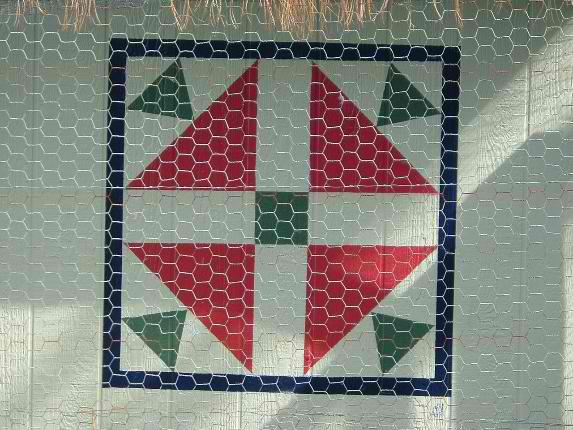
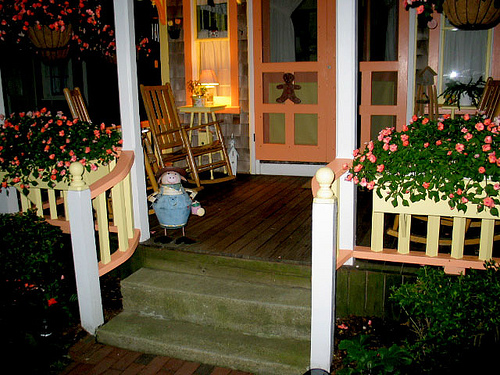


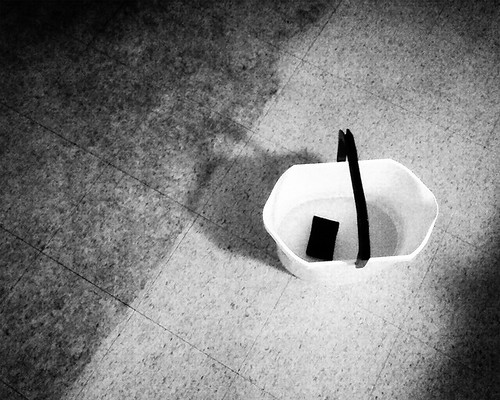
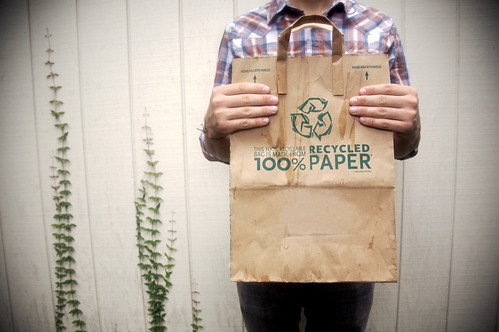
Recent comments
Aenean nonummy hendrerit mauris. Phasellus porta.